From Goethe University in Frankfurt comes Ms Lat Oct 110, a Use of Utrecht, Latin, book of hours from circa 1465. It's not the most beautiful of manuscripts, but has some interesting details. The calendar is nearly full, 350 days are populated. There are a number of Utrecht-specific saints, most obviously August 25 St. Gregory of Utrecht (see f.10v below), and there are also a unusual number of numeric saints. In addition to the usual ones, the Four Crowned Martyrs, Seven Sleepers, Seven Brothers and 11,000 Virgins, there are:
The obsession with numbers continues in the dating information, the calendar contains both Roman and Julian numbers for the dates, which is uncommon. Both of these are written in Hindu-Arabic numerals, which is, so far, unique. The golden numbers are still in Roman Numerals
(DB Id: 195)
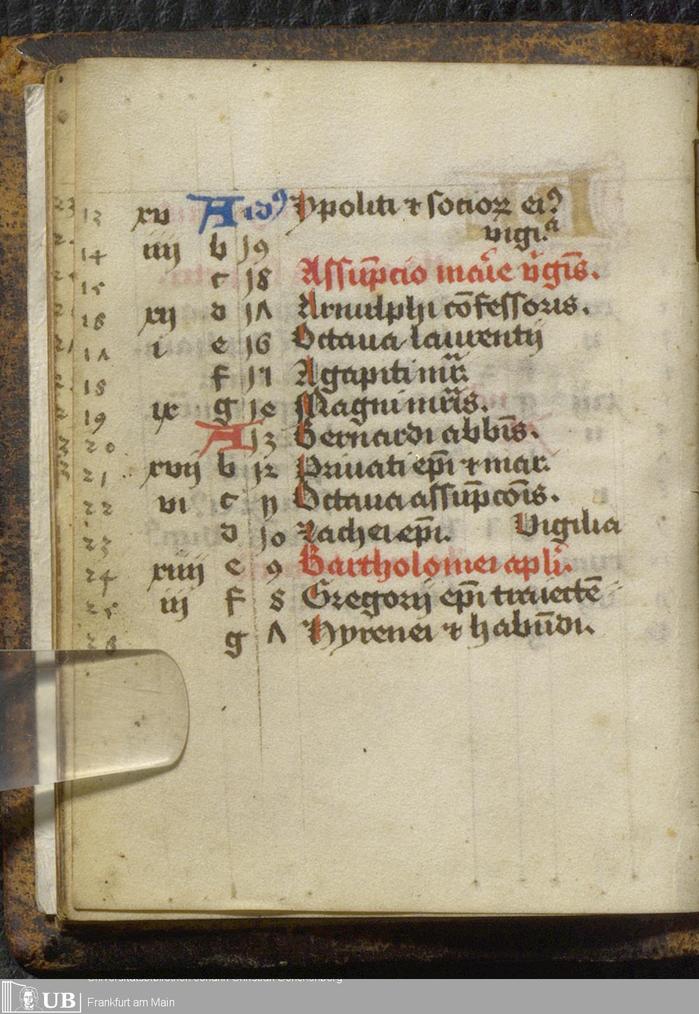
BPL MS q.med 131 (not available in their online catalogue), is a tiny (largest dimension is <4"), early (1320-1330) book of hours, Fransiscan Use, from Camerino, Italy. Despite the small size, the calendar is clear and readable where the ink is preserved. In addition to the feasts, there are notations of the signs of the zodiac in the calendar along with some liturgical notations, for example the earliest and latest dates for easter, and even the equinoctes and solstii. For an early calendar, the date range is unusually narrow due to notation in a later second hand, which has added some saints through the yeat, of the date 1338 at the end of April (see f.4v below). The 190 saints are irregularly spaced through the year, for example none in April before the 14th(see f.4r below), and the calendar is imperfect, there is no line for the 18 Kalends of October (Sept. 14).
(DB ID: 147)
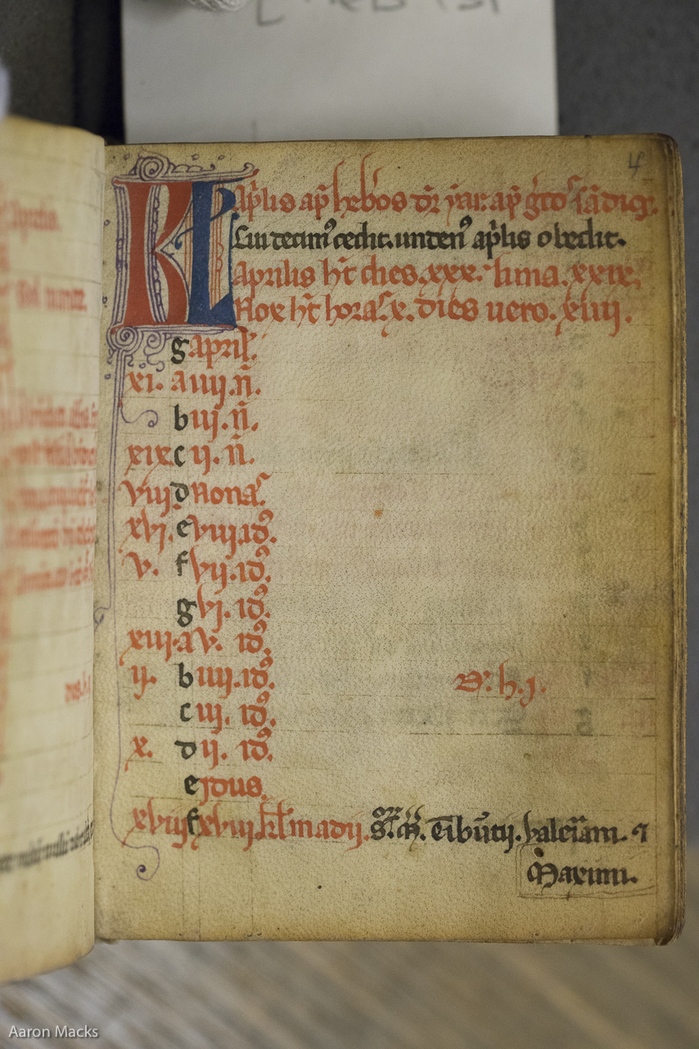
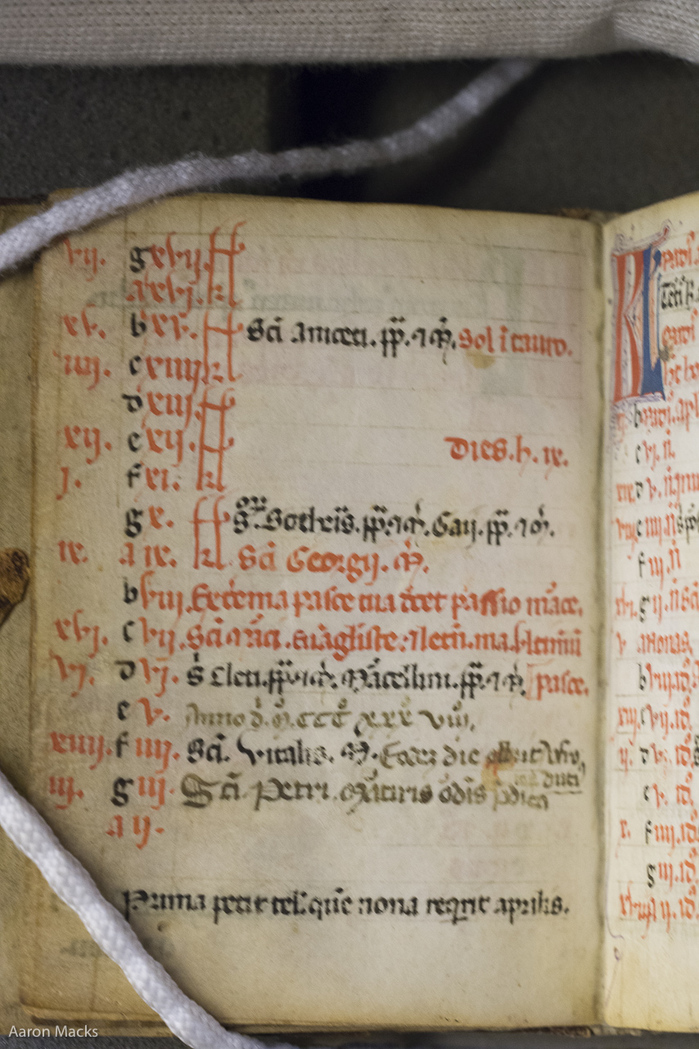
Another Use of Paris Book of Hours from the 15th Century, Boston Public Library MS q.med 82 is a nice, if not spectacular manuscript. The calendar is complete, and has a higher-than-usual number of errors (23), but not nearly as many as the recently added MS. 1841 (DB ID: 116). The calendar is complete except for a missing entry on October 21(see f.10v below), where Ursula and her 11,000 martyrs probably should have been.
(DB ID: 163)
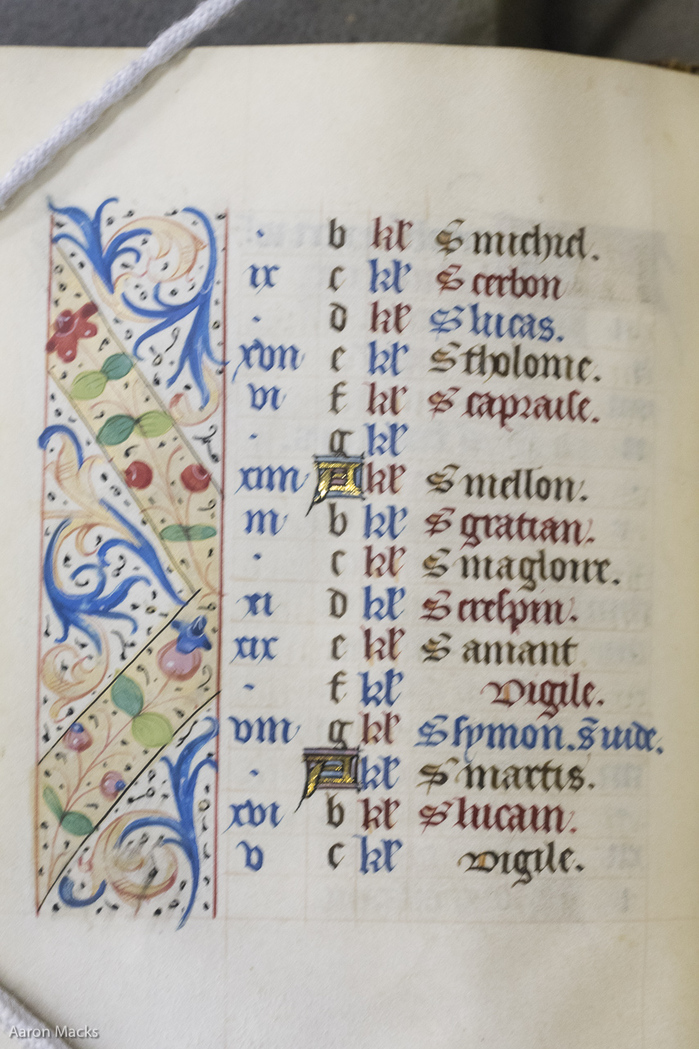
(Photo is mine, from the reading room, hence the low quality
At first blush Harvard's Houghton Library ms Lat 132 is a somewhat unremarkable Use of Rome Hours from Bruges. Though it has 12 lovely miniatures in the style of the "Gold Scrolls group", the calendar is rather boring, red and black with red strikethroughs for medium-importance days like vigils. It was updated at least 2 seperate times, with a second hand writing in black Gothic similar to the original and a third hand in a later batarde . Hidden in it, however, is an interesting clue to the literacy of its owners, October 9th(see f.Fv below). Written in red, this is the Feast of St. Denis, patron of the eponymous cathedral just north of Paris and the martyr for whom Montmartre is named. Denis is a adaptation of his actual Greek/Latin name, Dionysus. The first scribe wrote Dyonisi Epi (Dionysus Bishop), as expected for a calendar in Latin, but the second scribe appended "S. Denis", either not understanding that they are the same, or for a patron who might not know the Latin.
(Link to the DB: 135)
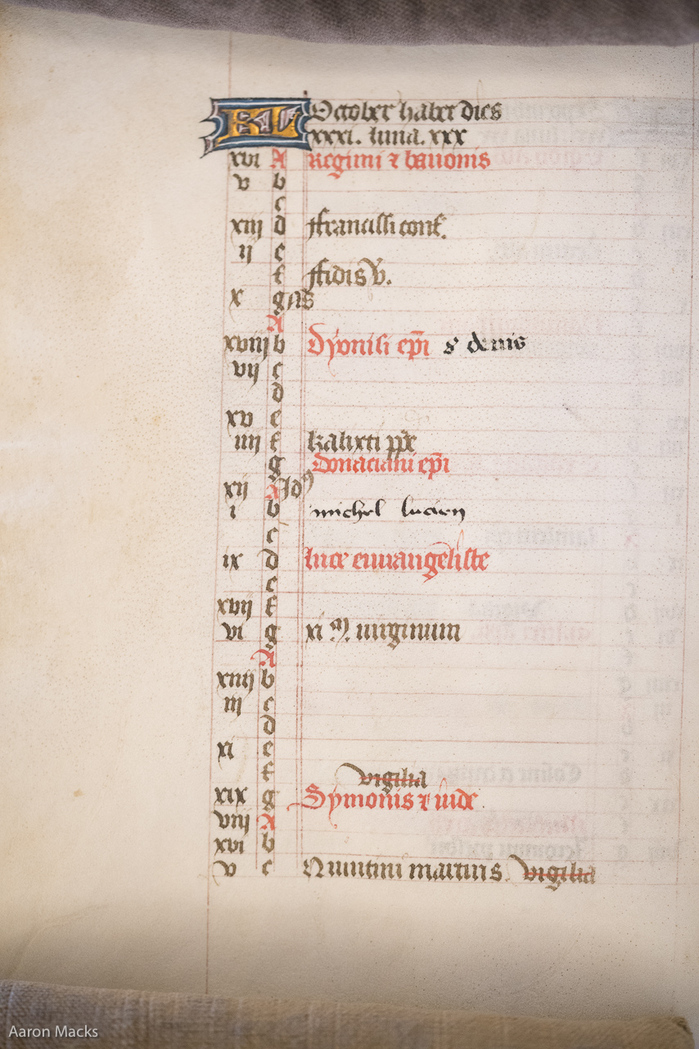
Bibliothèque nationale de France Nouvelle acquisition latine 3209 is another slightly odd, recently acquired Book of Hours. This one is Use of Rome, but calendar specific to Autun, and dated to right around 1450-1460. The calendar has several very specific-to-Autun entries, such as the “Revelation to St. Lazarus” on October 20(see in red f.5v below) and the “Dedication of the Church of St. Lazarus” on December 30th. The Cathedral of Autun is dedicated to St. Lazarus and has many of his relics, though in the early Middle Ages there was some confusion as to which Lazarus they had. This calendar is also somewhat unusual in calling out the Egyptian Days, which were thought to be especially inauspicious (see Oct 3 and 23). (See in the DB: 143)
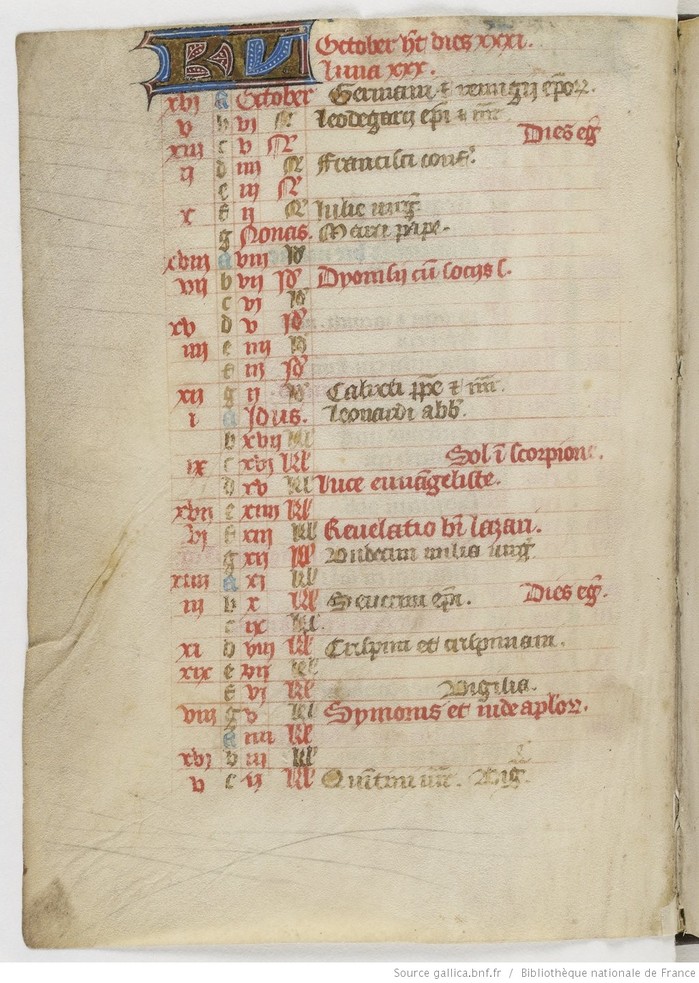
Today's addition is a fast DateConverter. the Date class can be used for conversion, usually by creating an object and then getting values, eg.
my $date = BOHdb::Date->new({ 'name' => 'id', 'values' => 283});
my $month = $date->get_month_num();
my $day = $date->get_standard_day();
However if that's the only reason to create the Date object, it's sorta inefficient to hit the DB in order to convert a date. For simple conversion between day_id (1-365) and month/day numbers the DateConverter class is MUCH faster. It's had the three relevant columns of the DB turned into big perl arrays and coded into the class directly, so a conversion is simply an array lookup. There are also the 2 functions in there to generate the static arrays, in case the backed data ever changes, the class is easy to update. The user only uses the 2 get functions, get_date_by_id and get_date_by_month_day. Both return a little hash with all the relevant data
{
'month' => 'October',
'day' => '10',
'id' => '283',
'month_num' => '10'
},
A quick timing test:
ok 1 - get_date_by_id returns a hashref in 0.000009 seconds
...
ok 5 - BOHdb::Date created in 0.027421 seconds
Another manuscript from the Richardson collection at Harvard's Houghton Library, Richardson 9 is a northern book, Use of Rome, from circa 1500, written in a very practiced Batarde hand. There are remarkably few errors in the completely-populated calendar and although it is not listed as such in the catalogues, the signs point to Bruges as the source of the calendar. The start of October (f.12v below) shows an interesting listing on the 3rd, Sts. Ewald and Ewald, 2 priests who died on the same day, are listed as "Duorum Enwaldorum", "The Two Enwalds"
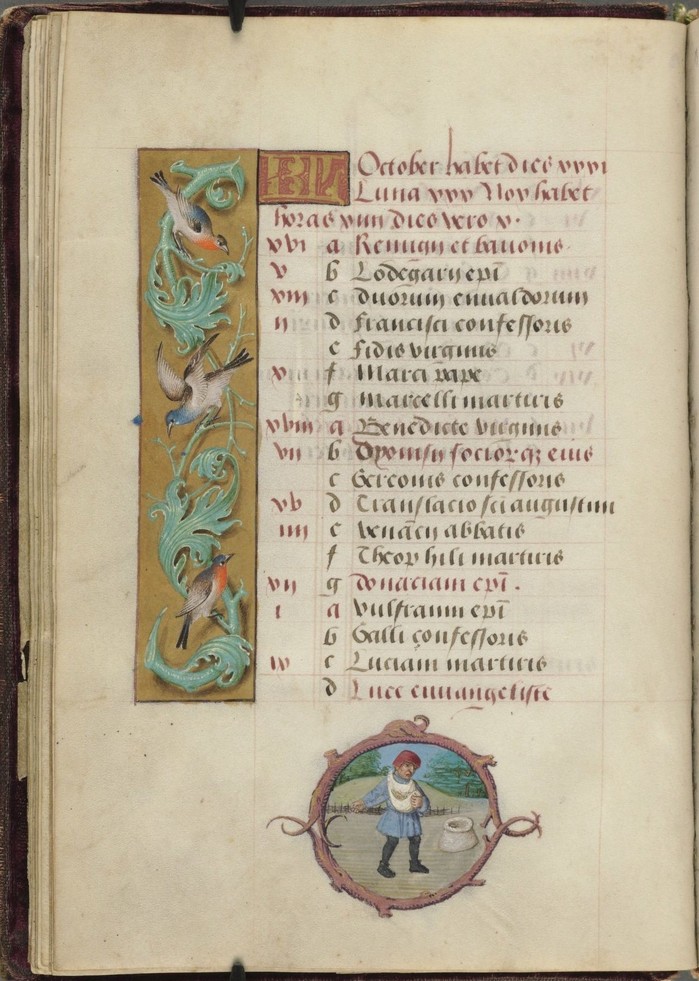
From the Richardson Collection at Harvard's Houghton Library comes MS Richardson 7, a lovely book from the Troyes/Sens area. The foliate decorations are more complex than many and very well executed, with an unusually accurate calendar. I was only able to detect 4 errors in copying out of 203 saints. Pictured is the second half of October with St. Simeon unusually alone, he is almost always listed with St Jude
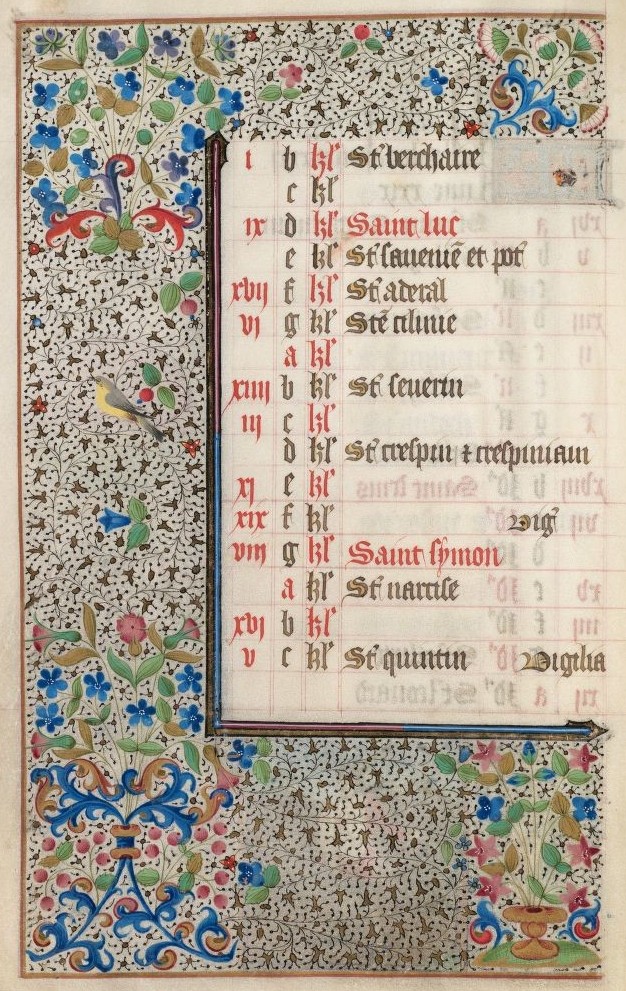
Some less exciting improvements, but improvements none the less:
- Started work on the saints class. Currently it can pull a saint from the Db and identify which calendars/manuscripts containt it. There's some logic to handle primary versus secondary, but it's only internal, not yet exposed. The feast_type tags are not yet integrated
- tests! I've been terribly remiss in writing unit tests, but I've been keeping up with them for the parts of Saint, and started some work to rebuild them for the Manuscript class. Also wrote one for basic class loading
- added an 'id' tag to each row of a calendar when output in the form day_monthnum-day, i.e. day_10-10 for October 10th, the feast of St Gereon. This will be used later for the "find all manuscripts with saint XXX" function







